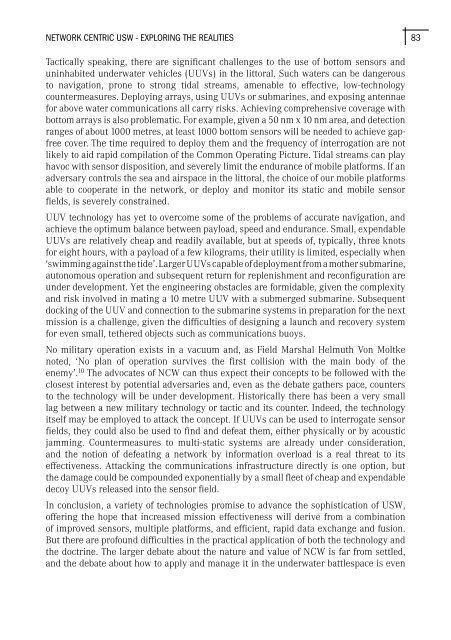Australian Maritime Issues 2005 - Royal Australian Navy
Australian Maritime Issues 2005 - Royal Australian Navy
Australian Maritime Issues 2005 - Royal Australian Navy
You also want an ePaper? Increase the reach of your titles
YUMPU automatically turns print PDFs into web optimized ePapers that Google loves.
NETWORK CENTRIC USW - EXPLORING THE REALITIES<br />
83<br />
Tactically speaking, there are significant challenges to the use of bottom sensors and<br />
uninhabited underwater vehicles (UUVs) in the littoral. Such waters can be dangerous<br />
to navigation, prone to strong tidal streams, amenable to effective, low-technology<br />
countermeasures. Deploying arrays, using UUVs or submarines, and exposing antennae<br />
for above water communications all carry risks. Achieving comprehensive coverage with<br />
bottom arrays is also problematic. For example, given a 50 nm x 10 nm area, and detection<br />
ranges of about 1000 metres, at least 1000 bottom sensors will be needed to achieve gapfree<br />
cover. The time required to deploy them and the frequency of interrogation are not<br />
likely to aid rapid compilation of the Common Operating Picture. Tidal streams can play<br />
havoc with sensor disposition, and severely limit the endurance of mobile platforms. If an<br />
adversary controls the sea and airspace in the littoral, the choice of our mobile platforms<br />
able to cooperate in the network, or deploy and monitor its static and mobile sensor<br />
fields, is severely constrained.<br />
UUV technology has yet to overcome some of the problems of accurate navigation, and<br />
achieve the optimum balance between payload, speed and endurance. Small, expendable<br />
UUVs are relatively cheap and readily available, but at speeds of, typically, three knots<br />
for eight hours, with a payload of a few kilograms, their utility is limited, especially when<br />
‘swimming against the tide’. Larger UUVs capable of deployment from a mother submarine,<br />
autonomous operation and subsequent return for replenishment and reconfiguration are<br />
under development. Yet the engineering obstacles are formidable, given the complexity<br />
and risk involved in mating a 10 metre UUV with a submerged submarine. Subsequent<br />
docking of the UUV and connection to the submarine systems in preparation for the next<br />
mission is a challenge, given the difficulties of designing a launch and recovery system<br />
for even small, tethered objects such as communications buoys.<br />
No military operation exists in a vacuum and, as Field Marshal Helmuth Von Moltke<br />
noted, ‘No plan of operation survives the first collision with the main body of the<br />
enemy’. 10 The advocates of NCW can thus expect their concepts to be followed with the<br />
closest interest by potential adversaries and, even as the debate gathers pace, counters<br />
to the technology will be under development. Historically there has been a very small<br />
lag between a new military technology or tactic and its counter. Indeed, the technology<br />
itself may be employed to attack the concept. If UUVs can be used to interrogate sensor<br />
fields, they could also be used to find and defeat them, either physically or by acoustic<br />
jamming. Countermeasures to multi-static systems are already under consideration,<br />
and the notion of defeating a network by information overload is a real threat to its<br />
effectiveness. Attacking the communications infrastructure directly is one option, but<br />
the damage could be compounded exponentially by a small fleet of cheap and expendable<br />
decoy UUVs released into the sensor field.<br />
In conclusion, a variety of technologies promise to advance the sophistication of USW,<br />
offering the hope that increased mission effectiveness will derive from a combination<br />
of improved sensors, multiple platforms, and efficient, rapid data exchange and fusion.<br />
But there are profound difficulties in the practical application of both the technology and<br />
the doctrine. The larger debate about the nature and value of NCW is far from settled,<br />
and the debate about how to apply and manage it in the underwater battlespace is even

















